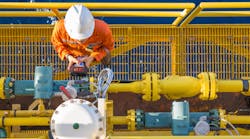Methods for sensing, monitoring, and communicating flow measurements continue to improve and expand. Designers of flow meters and regulators are answering the calls to unite simplicity with accuracy and repeatability. Safety certifications and precision technologies are accommodating crucial, specialized applications.
Hot tips for industrial electrical safety
Easiness in mind
Measurement instrumentation should be effective but also easy to use. For basic applications in all industries, the new Proline 10 Flowmeter line from Endress+Hauser is designed for simplicity as well as safety and reliability. The product line, comprised of electromagnetic (Promag) and Coriolis (Promass) flow meters, includes features such as a commissioning wizard, auto-rotatable LCD touch screen, and integrated device diagnostics.
Proline 10 allows for “simple commissioning, installation, and operation by intuitive interfaces such as the user guidance via display with touch screen or mobile operation via tablet or smartphone app,” observes Samuel Neeser, product manager of Coriolis Flowmeters at Endress+Hauser. “It simplifies every step in its life cycle from engineering to servicing, at the usual Endress+Hauser quality.”
The 4-20mA Type Dual Flow and Temperature Sensor from Sensaphone is a thermal flow meter with an integrated digital display that also provides real-time readings to any remote user with a Sensphone that accepts a 4-20mA signal. The user will receive an alarm that displays or reads the current flow rate when the rate falls outside the Sensphone’s programmed high or low limit
“A 4-20mA-type sensor that measures both flow and temperature with two current outputs is a simple yet versatile accessory that can protect pumps from damage during potential run-dry conditions. That’s because it lets users measure the flow rate of water, oil, glycol, or air in addition to the temperature of the medium flowing through the pipe,” says Dave DeFusco, VP of engineering at Sensaphone.
MEMS-based RedyCompact thermal mass flow meters and regulators from Sierra Instruments, a member of the TASI Group, are drop-in replacements for rotameters or “sight glass” volumetric variable area (VA) meters. Unlike rotameters, which only capture gas flow volume and are sensitive to gas pressure and temperature changes, the thermal flow meter measures gas mass flow directly and its performance is not affected by changes in temperature or pressure.
This article is part of our monthly Technology Toolbox column. Read more from Sheila Kennedy.
“RedyCompact is today’s digital equivalent of the old-style rotameter,” explains Scott Rouse, director of product management for TASi Gas Flow. “With stable, direct mass flow measurement, it provides a great technical solution.”
Ethernet capability is now available for ADMAG Total Insight (TI) AXG Series electromagnetic flow meters from Yokogawa, allowing for online control, configuration, and data collection. “Our Total Insight platform allows our customers to see everything that is happening in their processes. For example, features such as built-in-verification allow our customers to diagnose potential issues without taking the meter out of service,” observes Jason Pittman, field application specialist at Yokogawa.
ADMAG TI uses dual frequency excitation to maintain a good zero stability while managing flow noise. In addition, its flow tubes are manufactured to resist the thermal expansion and contraction that cause leaks in other meters, states Pittman.
Specialized applications
The new SIL 2 rated FS10i thermal flow transmitter from Fluid Components International (FCI) provides direct mass flow measurement for air, compressed air, or natural gas, in a compact inline or insertion configuration. Its safety integrity level (SIL) certification provides the user with “assurance that the instrument has been evaluated for a specific level of risk reduction—SIL 2 in this case,” says Eric Wible, FCI’s executive director of engineering.
This additional assessment evaluates the device’s ability to identify and provide an alert when the instrument recognizes specific internal faults, Wible explains. This requirement is critical for safety instrumented systems (SIS) used in refineries, chemical, and nuclear plants for added safety protection.
Ultrasonic wave technology powers the compact ES-FLOW volumetric liquid flow meters/controllers from Bronkhorst. Using ultrasound in a very small, straight sensor tube, it performs high-precision measurements of low flow rates, from 2 up to 1,500 ml/min, and is medium independent.
The ES-Flow series is especially suitable for measuring low liquid flows very quickly and accurately, such as for additives in food or in chemical research applications, notes Ferdinand Luimes, product manager of liquid flow-technologies at Bronkhorst. “The newest version, ES-113C, is mainly used in applications where only limited space is available (i.e., without display). A hygienic version is also available in a different form, including with display,” he adds.
This story originally appeared in the December 2021 issue of Plant Services. Subscribe to Plant Services here.


